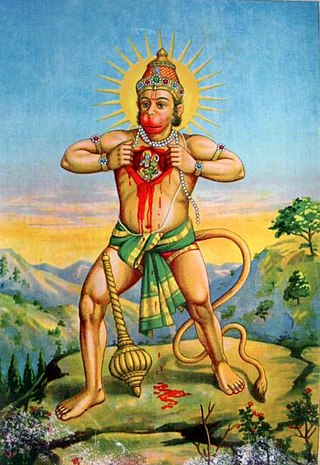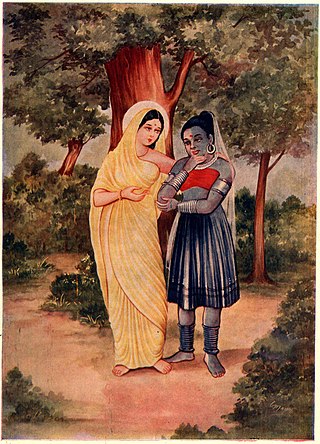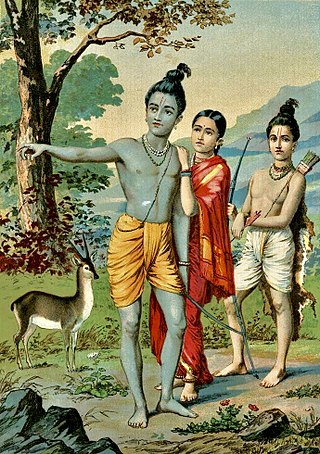
Ravana was a multi-headed rakshasa king of the island of Lanka, and the chief antagonist in the Hindu epic Ramayana. In the Ramayana, Ravana is described as the eldest son of sage Vishrava and Kaikasi. He abducted Prince Rama's wife, Sita, and took her to his kingdom of Lanka, where he held her in the Ashoka Vatika. Rama, with the support of vanara King Sugriva and his army of vanaras, launched an invasion against Ravana in Lanka. Ravana was subsequently slain, and Rama rescued his beloved wife Sita.

Hanuman, also known as Maruti, Bajrangabali, and Anjaneya, is a deity in Hinduism, revered as a divine vanara, and a devoted companion of the deity Rama. Central to the Ramayana, Hanuman is celebrated for his unwavering devotion to Rama and is considered a chiranjivi. He is traditionally believed to be the spiritual offspring of the wind deity Vayu, who is said to have played a significant role in his birth. In Shaiva tradition, he is regarded to be an incarnation of Shiva, while in most of the Vaishnava traditions he is the son and incarnation of Vayu. His tales are recounted not only in the Ramayana but also in the Mahabharata and various Puranas.

Sugriva, is a character In the ancient Indian epic Ramayana. He is the younger brother of Vali, whom he succeeded as ruler of the vanara kingdom of Kishkindha. Rumā is his wife. He is a son of Surya, the Hindu deity of the sun. As the king of the vanaras, Sugriva aided Rama in his quest to liberate his wife Sita from captivity at the hands of the rakshasa king Ravana.

Meghanada, also referred to by his epithet Indrajita, according to Hindu texts, was a son of Ravana and the crown prince of Lanka, who conquered Indraloka (Heaven). He is regarded as one of the greatest warriors in Hindu texts. He is a major character mentioned in the Indian epic Ramayana. Meghanada is the central character in Bengali ballad Meghnad Badh Kavya. He played an active role in the great war between Rama and Ravana. He acquired many kinds of celestial weapons from his Guru Shukra. His most prominent feat is having defeated the devas in heaven. Using the Brahmastra, Indrajita killed 670 million vanaras in a single day; nearly exterminating the entirety of the vanara race. No warrior had ever achieved this statistical feat before in the Ramayana. He is the only warrior in the entire Ramayana to defeat both Rama and Lakshmana twice while they were both armed by making them unconscious in a battle with the help of astras and sorcery. He was said to be more powerful and superior warrior than his father Ravana by Brahma and Agastya. He is the only warrior in the entire Hindu text to possess all three "Trimurti astras", namely, Brahmastra, Vaishnavastra, and Pashupatastra.

Sundara Kanda is the fifth book in the Hindu epic Ramayana. The original Sundara Kanda is in Sanskrit, and was composed in popular tradition by Valmiki, who was the first to scripturally record the Ramayana. Sundara Kanda is the only chapter of the Ramayana in which the principal protagonist is not Rama, but Hanuman. The work depicts the adventures of Hanuman and his selflessness, strength, and devotion to Rama are emphasised in the text. Hanuman is believed to have been fondly called “Sundara” by his mother Anjani, and Sage Valmiki is stated to have chosen this name over others as the Sundara Kanda is about Hanuman's journey to Lanka.

Sri Krishna Satya is a 1971 Indian Telugu-language Hindu mythological film directed by K. V. Reddy. It stars N. T. Rama Rao and Jayalalithaa, with music composed by Pendyala. The film was produced by N. Trivikrama Rao. It was the last film directed by the noted filmmaker K. V. Reddy.

Seetha Amman Temple, or Seetha Eliya Seethai Amman Thirukkovil, also known as Ashok Vatika Sita Temple, is an ancient Vaishnavite Hindu temple located in the Nuwara Eliya District of Central Sri Lanka. The temple's folklore is deeply connected to the Hindu epic, the Ramayana. According to the epic, after Sita was abducted by King Ravana of Lanka, she was brought to this location. Ravana sought vengeance against Rama and Lakshmana to avenge the disrespect shown to his sister, Shurpanakha.

Mahiravana is a 1940 Indian Telugu-language film directed by Chitrapu Narayana Rao and produced by Ghantasala Balaramayya under the banner of Kubera Films. Veteran actor Vemuri Gaggayya played Ahiravan.
Ramleela – Ajay Devgn Ke Saath, commonly known as Ramleela is a mythological on-stage musical drama, based on the famous Indian epic poem Ramayan. The show premiered on 21 October 2012 on Life OK and completed the story in five episodes on 18 November 2012. The show was narrated by Bollywood actor Ajay Devgn, who provided a prologue at the beginning of each episode or act. The show aired during the period from Dussehra in October till Diwali in November.

The Kothandaramaswamy Temple at Rameswaram, Tamil Nadu is a shrine dedicated to the Hindu deity Rama. The temple is Classified one among the 108 Abhimana Kshethram of Vaishnavate tradition. Located at a distance of 13 kilometres (8.1 mi) from Rameswaram, it forms the southernmost tip of the island. The temple is the only historical structure to survive the 1964 cyclone that washed away Dhanushkodi. The temple has the deities of Rama, Lakshmana, Sita, Hanuman and Vibhishana. The temple is surrounded by sea and remains a tourist attraction. It is easily accessible from Rameswaram.

Rama (Rāma), the hero of Ramayana, is described in the Jain scriptures as one of sixty-three illustrious persons, known as Salakapurusa. Among these, there are nine sets of Balabhadra, Vasudeva and Prati-Vasudeva. Rama was the 8th Balabhadra with Lakshmana and Ravana being his Vasudeva and Prati-Vasudeva counterparts. He is described as a young prince who is deprived of his throne and turned into a pauper. While living in exile his wife Sita is kidnapped by Ravana, King of Lanka. Rama then rescues Sita with the help of his brother Lakshmana and King Sugriva. Ravana is killed by Lakshmana and they both go into hell. Rama becomes a Jain muni and his soul attains moksha. Sita becomes a Jain sadhvi and is born into heaven as Indra.

Trijata is a rakshasi (demoness) in the Hindu epic Ramayana who is assigned the duty of guarding Sita who was kidnapped by the demon-king of Lanka Ravana. In later adaptions of Ramayana, Trijata is described as a daughter of Vibhishana, the brother of Ravana.

In the Hindu epic Ramayana, Sarama is the wife of Vibhishana, the brother of Ravana, the demon (rakshasa) king of Lanka. Sometimes, she is described as a rakshasi (demoness), at other times, she is said to have gandharva lineage. All accounts agree that Sarama was friendly to Sita, the consort of Rama, who was kidnapped by Ravana and imprisoned in Lanka. Like her husband who sides with Rama in the war against Ravana, Sarama is kind to Sita and aids Rama. Sarama and Vibhishana had a daughter called Trijata.

In the Hindu epic Ramayana, Nala, is the vanara (monkey), who is credited as the engineer of the Rama Setu, a bridge across the ocean between Rameswaram and Lanka, identified with modern-day Sri Lanka, so forces of the god Rama can pass over to Lanka. The bridge is also known as Nala Setu, the bridge of Nala. Along with Nala, another vanara who is his twin brother called Nila is also credited as the builder of the bridge. Nala is described as the architect of the vanaras. He is described as the son of the architect-god Vishwakarma. Nala is also described to have fought in the battle between Rama and Ravana, the king of Lanka.

Nila, also spelled as Neela, is a character in the Hindu epic Ramayana. He is a vanara chieftain in the army of Rama, the prince of Ayodhya and avatar of the god Vishnu. He is the commander-in-chief of the vanara army under the vanara king Sugriva, and is described as leading the army in Rama's battle against the rakshasa king Ravana of Lanka and as killing many rakshasas.

Chandrasena is a 1935 Hindi/Marathi mythology drama film directed by V. Shantaram for his Prabhat Film Company. The film was the first Indian trilingual film to be made simultaneously in Hindi, Marathi. The cinematographer was K. Dhiaber and the story and dialogue were by Shivram Vashikar. The music direction was by Keshavrao Bhole, with lyrics written by K. Narayan Kale. The cast included Nalini Tarkhud, Sureshbabu Mane, Kelkar, Rajani, Shantabai and Azurie.

Sri Rama Pattabhishekam is a 1978 Indian Telugu-language Hindu mythological film directed and produced by N. T. Rama Rao under Ramakrishna Cine Studios banner. Based on the Ramayana, the film stars Rama Rao, Jamuna and Sangeeta, with music composed by Pendyala Nageswara Rao.
Hanuman vs Mahiravana is a 2018 Indian epic adventure 2D and 3D stereoscopic animated film, made by Gamaya Inc, produced by Green Gold Animation Pvt Ltd and distributed by Yash Raj Films. Written by Narayanan Vaidyanathan and directed by Dr. Ezhil Vendan. It is the story of Hanuman and his attempts to free Rama and Lakshmana from the clutches of evil wizard Mahiravana. It focuses on the tale of Hanuman and his biggest battle with Ravana’s youngest step-brother, the king of Patala Mahiravana.

The exile of Rama is an event featured in the Ramayana, and is an important period in the life of Rama. In the epic, Rama is exiled by his father, Dasharatha, under the urging of his step-mother Kaikeyi, accompanied by his wife Sita and half-brother Lakshmana for 14 years. Rama's exile is a prelude to subsequent events of the epic, such as abduction of his wife Sita, his meeting with Hanuman and Sugriva, his battle with Ravana, and ultimately, the killing of Ravana, the purpose for which Vishnu had incarnated himself as Rama.



















